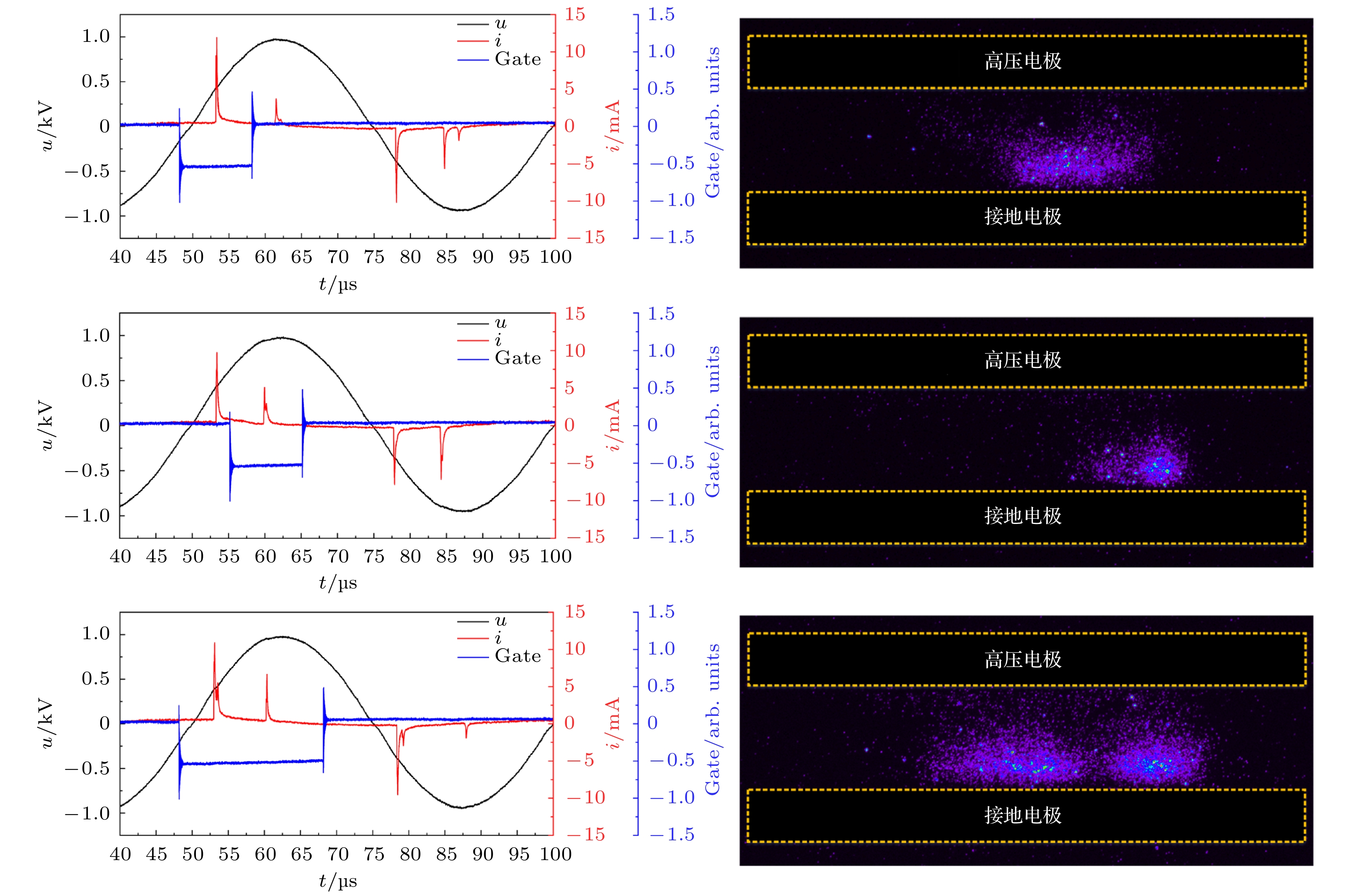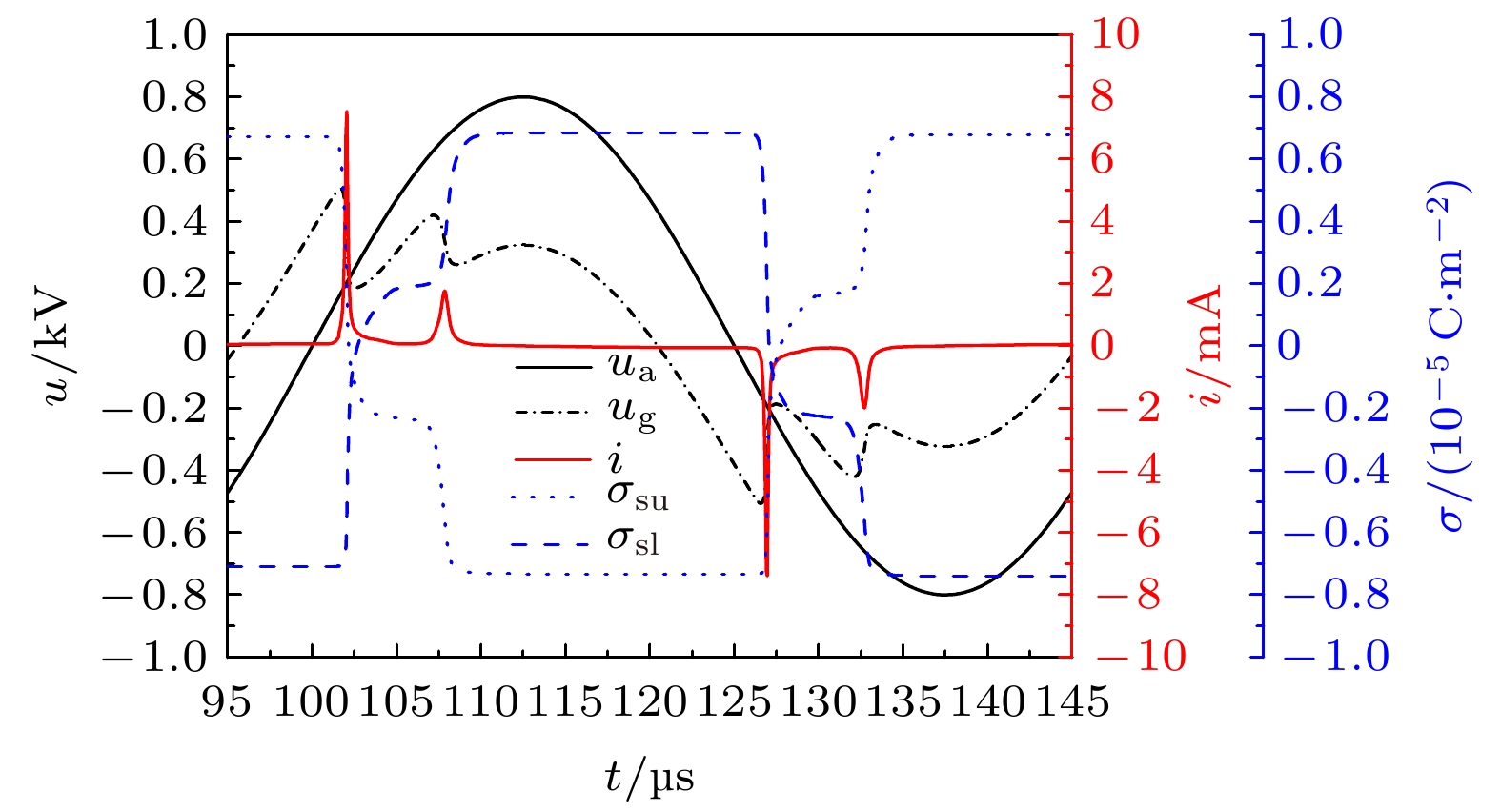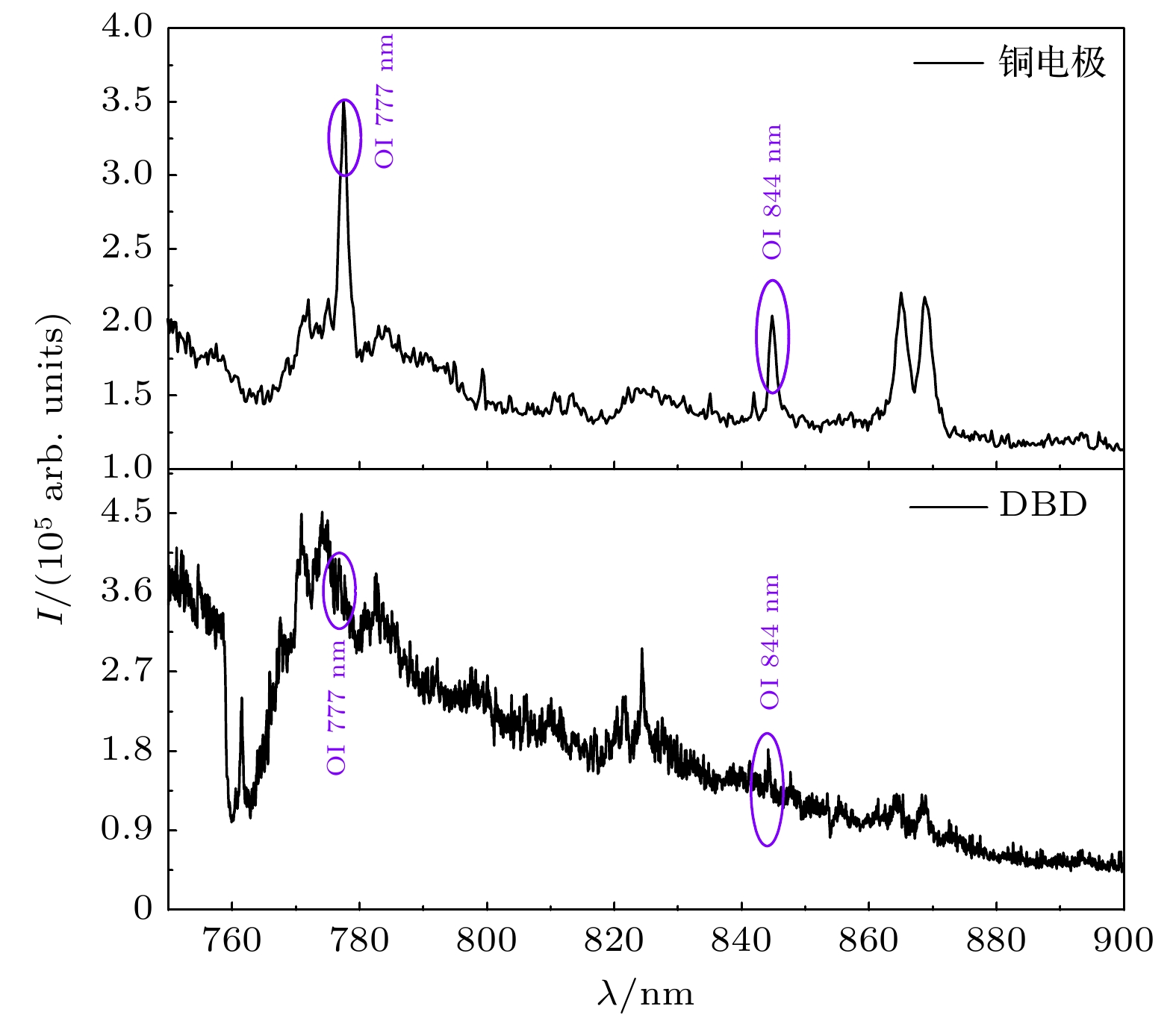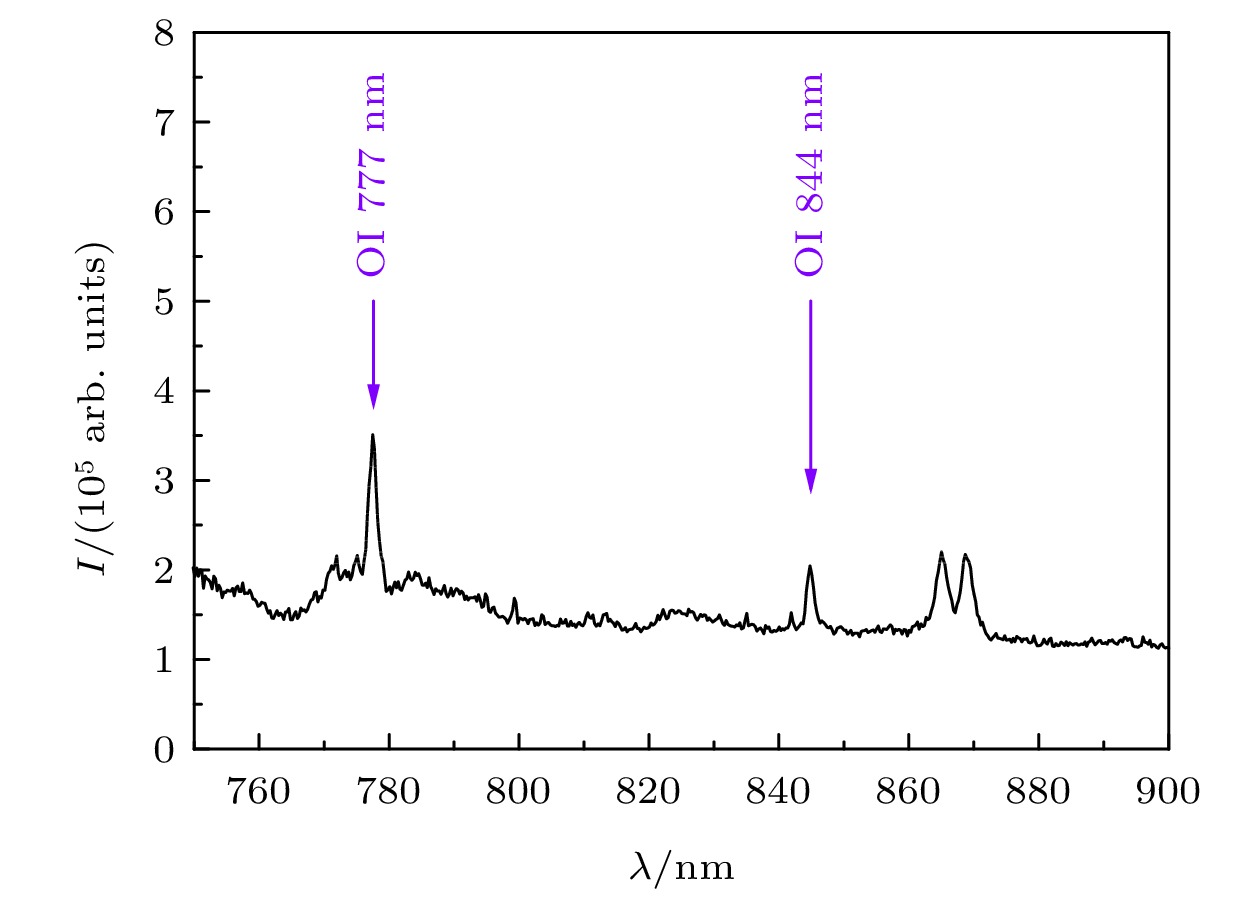-
火星大气富含CO2(~95%), 对其原位利用具有重要的科学和经济价值. 高压放电转化CO2具有绿色环保、可控程度高、使用寿命长等优势, 在火星CO2资源原位转化利用方面具有应用潜力. 本文模拟火星低气压条件下CO2氛围, 针对kHz交流电压驱动两种典型电极结构(有/无阻挡介质)的放电特性开展对比实验研究, 并辅以数值仿真分析两种电极结构下CO2放电产物及其转化途径. 结果表明, 引入阻挡介质后, 由于介质表面累积电荷和空间电荷畸变电场导致放电从半周期单次放电转变为多脉冲放电, 不同放电脉冲对应的放电通道随机产生. 主要放电产物中, CO依赖阴极位降区边界处电子与CO2附着分解反应产生, O2大部分产生于瞬时阳极表面或瞬时阳极侧介质表面电子与CO
${}^+_2 $ 复合分解反应. 进一步发现, 介质引入不改变二者产生位置和主导反应路径, 但会降低阴极位降区边界处电子密度和电子温度, 使CO产量有所减少; 并降低放电功率, 使到达瞬时阳极表面和瞬时阳极侧介质表面的CO${}^+_2 $ 产额不足, 生成O2减少.The low-pressure atmosphere rich in CO2 (~95%) on Mars makes the in-situ resource utilization of Martian CO2 and the improvement of oxidation attract widespread attention. It contributes to constructing the Mars base which will support the deep space exploration. Conversion of CO2 based on high voltage discharge has the advantages of environmental friendliness, high efficiency and long service life. It has application potential in the in-situ conversion and utilization of Martian CO2 resources. We simulate the CO2 atmosphere of Mars where the pressure is fixed at 1 kPa and the temperature is maintained at room temperature. A comparative study is carried out on the discharge characteristics of two typical electrode structures (with/without barrier dielectric) driven by 20 kHz AC voltage. Combined with numerical simulations, the CO2 discharge characteristics, products and their conversion pathways are analyzed. The results show that the discharge mode changes from single discharge during each half cycle into multi discharge pulses after adding the barrier dielectric. Each discharge pulse of the multi pulses corresponds to a random discharge channel, which is induced by the distorted electric field of accumulated charge on the dielectric surface and the space charge. The accumulated charge on the dielectric surface promotes the primary discharge and inhibits the secondary discharge. Space charge will be conducive to the occurrence of secondary discharge. The main products in discharge process include${\rm{CO}}^+_2 $ , CO, O2, C, and O. Among the products, CO is produced mainly by the attachment decomposition reaction between energetic electrons and CO2 at the boundary of cathode falling zone, and the contribution rate of the reaction can reach about 95%. The O2 is generated mainly by the compound decomposition reaction between electrons and${\rm{CO}}^+_2 $ near the instantaneous anode surface or instantaneous anode side dielectric surface, and the contribution rate of the reaction can reach about 98%. It is further found that the dielectric does not change the generation position nor dominant reaction pathway of the two main products, but will reduce the electron density from 5.6×1016 m−3 to 0.9×1016 m−3 and electron temperature from 17.2 eV to 11.7 eV at the boundary of the cathode falling region, resulting in the reduction of CO production. At the same time, the deposited power is reduced, resulting in insufficient$ {\rm{CO}}^+_2 $ yield near the instantaneous anode surface and instantaneous anode side dielectric surface and further the decrease of O2 generation.-
Keywords:
- low pressure CO2 /
- discharge characteristics /
- discharge products /
- reaction pathway
[1] Mahaffy P R, Webster C R, Atreya S K, et al. 2013 Science 341 263
 Google Scholar
Google Scholar
[2] Starr S O, Muscatello A C 2020 Planet. Space Sci. 182 104824
 Google Scholar
Google Scholar
[3] 欧阳自远, 肖福根 2012 航天器环境工程 29 591
 Google Scholar
Google Scholar
Ouyang Z Y, Xiao F G 2012 Spacecraft Environment Engineering 29 591
 Google Scholar
Google Scholar
[4] Ashford B, Tu X 2017 Curr. Opin. Green Sustain. Chem. 3 45
 Google Scholar
Google Scholar
[5] Wang W, Wang S, Ma X, Gong J 2011 Chem. Soc. Rev. 40 3703
 Google Scholar
Google Scholar
[6] Ganesh I 2014 Renew. Sust. Energ. Rev. 31 221
 Google Scholar
Google Scholar
[7] Ganesh I 2016 Renew. Sust. Energ. Rev. 59 1269
 Google Scholar
Google Scholar
[8] Wendt G L, Farnsworth M 1925 J. Am. Chem. Soc. 47 2494
 Google Scholar
Google Scholar
[9] Mei D, He Y, Liu S, Yan J, Tu X 2016 Plasma Process. Polym. 13 544
 Google Scholar
Google Scholar
[10] Snoeckx R, Heijkers S, Van Wesenbeeck K, Lenaerts S, Bogaerts A 2016 Energ. Environ. Sci. 9 999
 Google Scholar
Google Scholar
[11] Lu N, Zhang C, Shang K, Jiang N, Li J, Wu Y 2019 J. Phys. D Appl. Phys. 52 224003
 Google Scholar
Google Scholar
[12] Kozak T, Bogaerts A 2015 Plasma Sources Sci. T. 24 015024
 Google Scholar
Google Scholar
[13] Silva T, Britun N, Godfroid T, Snyders R 2014 Plasma Sources Sci. T. 23 025009
 Google Scholar
Google Scholar
[14] Spencer L F, Gallimore A D 2013 Plasma Sources Sci. T. 22 015019
 Google Scholar
Google Scholar
[15] Wang W, Berthelot A, Kolev S, Tu X, Bogaerts A 2016 Plasma Sources Sci. T. 25 065012
 Google Scholar
Google Scholar
[16] 张凯, 张帅, 高远, 孙昊, 严萍, 邵涛 2019 高电压技术 45 1396
Zhang K, Zhang S, Gao Y, Sun H, Yan P, Shao T 2019 High Voltage Engineering 45 1396
[17] Chen Q, Sun J, Zhang X 2018 Chinese J. Chem. Eng. 26 1041
 Google Scholar
Google Scholar
[18] Ponduri S, Becker M M, Welzel S, van de Sanden M C M, Loffhagen D, Engeln R 2016 J. Appl. Phys. 119 093301
 Google Scholar
Google Scholar
[19] Aerts R, Martens T, Bogaerts A 2012 J. Phys. Chem. C. 116 23257
 Google Scholar
Google Scholar
[20] Capitelli M, Celiberto R, Colonna G, et al. 2011 Plasma Phys. Contr. F. 53 124007
 Google Scholar
Google Scholar
[21] Pietanza L D, Colonna G, D'Ammando G, Capitelli M 2017 Plasma Phys. Contr. F. 59 014035
 Google Scholar
Google Scholar
[22] Ozkan A, Dufour T, Silva T, Britun N, Snyders R, Bogaerts A, Reniers F 2016 Plasma Sources Sci. T. 25 025013
 Google Scholar
Google Scholar
[23] Brehmer F, Welzel S, van de Sanden M C M, Engeln R 2014 J. Appl. Phys. 116 123303
 Google Scholar
Google Scholar
[24] Ozkan A, Dufour T, Bogaerts A, Reniers F 2016 Plasma Sources Sci. T. 25 045016
 Google Scholar
Google Scholar
[25] Gruenwald J 2016 Acta Astronaut. 123 188
 Google Scholar
Google Scholar
[26] Guerra V, Silva T, Ogloblina P, et al. 2017 Plasma Sources Sci. T. 26 11LT01
 Google Scholar
Google Scholar
[27] Ogloblina P, Morillo-Candas A S, Silva A F, et al. 2021 Plasma Sources Sci. T. 30 065005
 Google Scholar
Google Scholar
[28] Zhang B, Zhang X 2020 J. Appl. Phys. 128 083302
 Google Scholar
Google Scholar
[29] Wang C, Fu Q, Chang Z, Zhang G 2021 Plasma Process. Polym. 18 e2000228
 Google Scholar
Google Scholar
[30] Wang C, Yao C, Chang Z, Zhang G 2019 Phys. Plasmas 26 123506
 Google Scholar
Google Scholar
[31] Kozak T, Bogaerts A 2014 Plasma Sources Sci. T. 23 045004
 Google Scholar
Google Scholar
[32] Lowke J J, Phelps A V, Irwin B W 1973 J. Appl. Phys. 44 4664
 Google Scholar
Google Scholar
[33] Land J E 1978 J. Appl. Phys. 49 5716
 Google Scholar
Google Scholar
[34] Lawton S A, Phelps A V 1978 J. Chem. Phys. 69 1055
 Google Scholar
Google Scholar
[35] Hokazono H, Fujimoto H 1987 J. Appl. Phys. 62 1585
 Google Scholar
Google Scholar
[36] Beuthe T G, Chang J S 1997 Jpn. J. Appl. Phys. Part 1-Regul. Pap. Short Notes Rev. Pap. 36 4997
 Google Scholar
Google Scholar
[37] Cenian A, Chernukho A, Borodin V, Sliwinski G 1994 Contrib. Plasm. Phys. 34 25
 Google Scholar
Google Scholar
[38] Eliasson B, Hirth M, Kogelschatz U 1987 J. Phys. D Appl. Phys. 20 1421
 Google Scholar
Google Scholar
[39] Cenian A, Chernukho A, Borodin V 1995 Contrib. Plasm. Phys. 35 273
 Google Scholar
Google Scholar
[40] Gudmundsson J T, Thorsteinsson E G 2007 Plasma Sources Sci. T. 16 399
 Google Scholar
Google Scholar
[41] Woodall J, Agundez M, Markwick-Kemper A J, Millar T J 2007 Astron. Astrophys. 466 1197
 Google Scholar
Google Scholar
[42] Hadjziane S, Held B, Pignolet P, Peyrous R, Coste C 1992 J. Phys. D Appl. Phys. 25 677
 Google Scholar
Google Scholar
[43] Blauer J A, Nickerson G R 1974 AIAA 7th Fluid and Plasma Dynamics Conference Pal0 Alto, California, June 17–19, 1974 p536
[44] Poncin-Epaillard F, Aouinti M 2002 Plasmas Polym. 7 1
 Google Scholar
Google Scholar
[45] Khan M I, Rehman N U, Khan S, Ullah N, Masood A, Ullah A 2019 AIP Adv. 9 085015
 Google Scholar
Google Scholar
[46] 谢维杰 2008 博士学位论文 (上海: 上海交通大学)
Xie W J 2008 Ph. D. Dissertation (Shanghai: Shanghai Jiaotong Universitty) (in Chinese)
[47] Wang X, Gao Y, Zhang S, Sun H, Li J, Shao T 2019 Appl. Energ. 243 132
 Google Scholar
Google Scholar
[48] Liu Z, Huang B, Zhu W, Zhang C, Tu X, Shao T 2020 Plasma Chem. Plasma P. 40 937
 Google Scholar
Google Scholar
-
表 1 模型中包括的粒子
Table 1. Types of particles included in the model.
中性粒子 CO2, CO, O, C, O2 离子 CO${}^+_2 $, O–, O${}^+_2 $, O${}^-_2 $, CO${}^-_3 $ 激发态粒子 CO2e, CO2v1, CO2v2, CO2v3, CO2v4 表 2 模型中考虑的振动态
Table 2. Vibrational particles considered in the model.
基态 模型中的符号 对应振动态 CO2 CO2v1 (010) CO2v2 (100), (020) CO2v3 (001) CO2v4 (n00), (0n0) 表 3 模型中裸电极与DBD放电参数和产物对比
Table 3. Comparison of discharge parameters and products in model: bare copper electrode & DBD.
放电参数和产物 裸电极 DBD 功率/W 1.0 0.06 电子密度/m–3 1.1 × 1016 3.6 × 1015 振动态密度和/m–3 1.0 × 1021 3.1 × 1019 CO密度/m–3 2.2 × 1017 7.0 × 1015 O2密度/m–3 8.8 × 1016 2.7 × 1015 O密度/m–3 4.2 × 1016 1.5 × 1015 C密度/m–3 3.5 × 1015 6.3 × 1014 表 B2 模型中的电子附着反应和电子-离子复合反应
Table B2. Electron attachment reactions and electron-ion recombination reactions in the model.
序号 反应 速率系数 参考文献 E22 e + CO${}_2^+ $ → CO + O 2.0 × 10–11Te–0.5/Tg [35] E23 e + CO${}_2^+ $ → C + O2 3.94 × 10–13Te–0.4 [36] E24 e + O${}_2^+ $ → O + O 6.0 × 10–13Te–0.5Tg–0.5 [35] E25 e + O2 + M → M + O${}_2^- $ 3.0 × 10–42 (M = CO2) [37] 2.0 × 10–42 (M = CO, O2) E26 e + O + M → M + O– 1.0 × 10–43 [37] E27 e + O${}_2^+ $ + M → M + O2 1.0 × 10–38 [31, 38] 表 B3 模型中的离子-中性粒子反应和离子-离子反应
Table B3. Ion-neutral particle reactions and ion-ion reactions in the model.
序号 反应 速率系数 参考文献 I1 O– + CO2 +M→ CO${}_3^- $ + M 9.0 × 10–41 (M = CO2) [35, 39] 3.0 × 10–40 (M = CO, O2) I2 O– + CO → CO2 + e 5.5 × 10–16 [36] I3 CO${}_3^- $ + CO → CO2 + CO2 + e 5.0 × 10–19 [35] I4 O– + M → O + M + e 4.0 × 10–18 [39] I5 O– + O → O2 + e 2.3 × 10–16 [40] I6 O${}_2^- $ + CO${}_2^+ $ → CO + O2 + O 6.0 × 10–13 [35] I7 O + CO${}_2^+ $ → CO + O${}_2^+ $ 1.64 × 10–16 [31, 41] I8 O2 + CO${}_2^+ $ → CO2 + O${}_2^+ $ 5.3 × 10–17 [31, 41] I9 CO${}_3^- $ + CO${}_2^+ $ → CO2 + CO2 + O 5.0 × 10–13 [35] I10 CO${}_3^- $ + O${}_2^+ $ → CO2 + O2 + O 3.0 × 10–13 [35] I11 CO${}_3^- $ + O → CO2 + O${}_2^- $ 8.0 × 10–17 [35] I12 O${}_2^- $ + O${}_2^+ $ → O2 + O2 2.0 × 10–13 [40] I13 O${}_2^- $ + O${}_2^+ $ → O + O + O2 4.2 × 10–13 [35] I14 O${}_2^- $ + O${}_2^+ $ + M → O2 + O2 + M 2.0 × 10–37 [38] I15 O– + O${}_2^+ $ → O + O2 1.0 × 10–13 [35] I16 O– + O${}_2^+ $ → O + O + O 2.6 × 10–14 [40] I17 O${}_2^- $ + O → O– + O2 3.3 × 10–16 [38] I18 O${}_2^- $ + O2 → O2 + O2 +e 2.18 × 10–24 [38] I19 O${}_2^- $ +M → O2 + M +e 2.7 × 10–16(Tg/300)0.5exp(–5590/Tg) [36] 表 B4 模型中中性粒子之间的反应
Table B4. Reactions between neutral particles in the model.
序号 反应 速率系数 α 参考文献 N1 CO2 +M → CO + O + M 3.91 × 10–16exp(–49430/Tg) 0.8 [31] N2 CO2 + O → CO + O2 2.8 × 10–17exp(–26500/Tg) 0.5 [31, 36] N3 CO2 + C→ CO + CO 1.0 × 10–21 — [39] N4 O + CO +M → CO2 + M 1.6 × 10–45exp(–1510/Tg) (M=CO2) [37] 8.2 × 10–46exp(–1510/Tg) (M=CO, O2) N5 O + C +M → CO + M 2.14 × 10–41(Tg/300)–3.08exp(–2114/Tg) [36] N6 O + O +M → O2 + M 1.27 × 10–44(Tg/300)–1exp(–170/Tg) [42] N7 O2 + CO → CO2 + O 4.2 × 10–18exp(–24000/Tg) [36] N8 O2 + C → CO + O 3.0 × 10–17 [37] 表 B5 模型中的振动能量传递反应
Table B5. Vibration energy transfer reactions in the model.
序号 反应 速率系数 参考文献 V1 CO2v1 + CO2 → CO2 + CO2 7.14 × 10–14exp(–177 Tg–1/3+451 Tg–2/3) [43] V2 CO2v1 + CO → CO + CO2 0.7 × 7.14 × 10–14exp(–177 Tg–1/3+451 Tg–2/3) [43] V3 CO2v1 + O2 → O2 + CO2 0.7 × 7.14 × 10–14exp(–177 Tg–1/3+451 Tg–2/3) [43] V4 CO2v2 + CO2 → CO2 + CO2 1.071 × 10–15exp(–137 Tg–1/3) [43] V5 CO2v2 + CO → CO + CO2 3.1 × 1.071 × 10–15exp(–137 Tg–1/3) [43] V6 CO2v2 + O2 → O2 + CO2 3.1 × 1.071 × 10–15exp(–137 Tg–1/3) [43] V7 CO2v2 + CO2 → CO2 + CO2v1 1.942 × 10–13exp(–177 Tg–1/3+451 Tg–2/3) [43] V8 CO2v2 + CO → CO + CO2v1 0.7 × 1.942 × 10–13exp(–177 Tg–1/3+451 Tg–2/3) [43] V9 CO2v2 + O2 → O2 + CO2v1 0.7 × 1.942 × 10–13exp(–177 Tg–1/3+451 Tg–2/3) [43] V10 CO2v3 + CO2 → CO2 + CO2v2 8.57 × 10–7exp(–404 Tg–1/3+1096 Tg–2/3) [43] V11 CO2v3 + CO → CO + CO2v2 0.3 × 8.57 × 10–7exp(–404 Tg–1/3+1096 Tg–2/3) [43] V12 CO2v3 + O2 → O2 + CO2v2 0.4 × 8.57 × 10–7exp(–404 Tg–1/3+1096 Tg–2/3) [43] V13 CO2v3 + CO2 → CO2 + CO2v4 1.431 × 10–11exp(–252 Tg–1/3+685 Tg–2/3) [43] V14 CO2v3 + CO → CO + CO2v4 0.3 × 1.431 × 10–11exp(–252 Tg–1/3+685 Tg–2/3) [43] V15 CO2v3 + O2 → O2 + CO2v4 0.4 × 1.431 × 10–11exp(–252 Tg–1/3+685 Tg–2/3) [43] V16 CO2v3 + CO2 → CO2v1 + CO2v2 1.06 × 10–11exp(–242 Tg–1/3+633 Tg–2/3) [43] V17 CO2v3 + CO2 → CO2 + CO2v1 4.25 × 10–7exp(–407 Tg–1/3+824 Tg–2/3) [43] V18 CO2v3 + CO → CO + CO2v1 0.3 × 4.25 × 10–7exp(–407 Tg–1/3+824 Tg–2/3) [43] V19 CO2v3 + O2 → O2 + CO2v1 0.4 × 4.25 × 10–7exp(–407 Tg–1/3+824 Tg–2/3) [43] V20 CO2v4 + CO2 → CO2 + CO2v2 2.897 × 10–13exp(–177 Tg–1/3+451 Tg–2/3) [43] V21 CO2v4 + CO → CO + CO2v2 0.7 × 2.897 × 10–13exp(–177 Tg–1/3+451 Tg–2/3) [43] V22 CO2v4 + O2 → O2 + CO2v2 0.7 × 2.897 × 10–13exp(–177 Tg–1/3+451 Tg–2/3) [43] V23 CO2v4 + CO2 → CO2 + CO2v1 1.071 × 10–15exp(–137 Tg–1/3) [43] V24 CO2v4 + CO → CO + CO2v1 3.1 × 1.071 × 10–15exp(–137 Tg–1/3) [43] V25 CO2v4 + O2 → O2 + CO2v1 3.1 × 1.071 × 10–15exp(–137 Tg–1/3) [43] 表 B1 模型中的电子碰撞反应
Table B1. Electron impact reactions in the model.
序号 反应 速率系数 参考文献 E1 e + CO2 → e + CO2 f (σ) [32] E2 e + CO2vi → e + CO2vi f (σ) [32] E3 e + CO2 → 2e + CO${}_2^+ $ f (σ) [32] E4 e + CO2vi → 2e + CO${}_2^+ $ f (σ) [32] E5 e + CO2 → e + CO2e f (σ) [32] E6 e + CO2vi → e + CO2e f (σ) [32] E7 e + CO2 → e + O + CO f (σ) [32] E8 e + CO2vi → e + O + CO f (σ) [32] E9 e + CO2 → O– + CO f (σ) [32] E10 e + CO2vi → O– + CO f (σ) [32] E11 e + CO2 → e + CO2v1 f (σ) [32] E12 e + CO2 → e + CO2v2 f (σ) [32] E13 e + CO2 → e + CO2v3 f (σ) [32] E14 e + CO2 → e + CO2v4 f (σ) [32] E15 e + CO → e + CO f (σ) [33] E16 e + CO → e + C + O f (σ) [33] E17 e + CO → C + O– f (σ) [33] E18 e + O2 → e + O2 f (σ) [34] E19 e + O2 → e + O + O f (σ) [34] E20 e + O2 → O + O– f (σ) [34] E21 e + O2 → 2e + O${}_2^+ $ f (σ) [34] 表 C3 CO(A1Π→X1Σ)第四正带系的光谱参数
Table C3. Spectral parameters of the fourth positive band system of CO(A1Π→X1Σ).
波长/nm 振动能级(ν'→ν'') Δν 200.5 1→8 7 208.9 5→12 7 221.6 3→12 9 224.7 8→16 8 228.6 6→15 9 235.6 5→15 10 表 C4 CO+(B2Σ+→X2Σ+)第一负带系的光谱参数
Table C4. Spectral parameters of the first negative band system of CO+(B2Σ+→X2Σ+).
波长/nm 振动能级(ν'→ν'') Δν 244.5 1→3 2 247.4 2→4 2 253.0 4→6 2 257.7 1→4 3 表 C1 CO(b3Σ→a3Π)第三正带系的光谱参数
Table C1. Spectral parameters of the third positive band system of CO(b3Σ→a3Π).
波长/nm 振动能级(ν'→ν'') Δν 283 0→0 0 297 0→1 1 313 0→2 2 表 C2 CO(B1Σ→A1Π)Angstrom系的光谱参数
Table C2. Spectral parameters of the Angstrom system of CO(B1Σ→A1Π).
波长/nm 振动能级(ν'→ν'') Δν 451 0→0 0 483 0→1 1 520 0→2 2 561 0→3 3 608 0→4 4 -
[1] Mahaffy P R, Webster C R, Atreya S K, et al. 2013 Science 341 263
 Google Scholar
Google Scholar
[2] Starr S O, Muscatello A C 2020 Planet. Space Sci. 182 104824
 Google Scholar
Google Scholar
[3] 欧阳自远, 肖福根 2012 航天器环境工程 29 591
 Google Scholar
Google Scholar
Ouyang Z Y, Xiao F G 2012 Spacecraft Environment Engineering 29 591
 Google Scholar
Google Scholar
[4] Ashford B, Tu X 2017 Curr. Opin. Green Sustain. Chem. 3 45
 Google Scholar
Google Scholar
[5] Wang W, Wang S, Ma X, Gong J 2011 Chem. Soc. Rev. 40 3703
 Google Scholar
Google Scholar
[6] Ganesh I 2014 Renew. Sust. Energ. Rev. 31 221
 Google Scholar
Google Scholar
[7] Ganesh I 2016 Renew. Sust. Energ. Rev. 59 1269
 Google Scholar
Google Scholar
[8] Wendt G L, Farnsworth M 1925 J. Am. Chem. Soc. 47 2494
 Google Scholar
Google Scholar
[9] Mei D, He Y, Liu S, Yan J, Tu X 2016 Plasma Process. Polym. 13 544
 Google Scholar
Google Scholar
[10] Snoeckx R, Heijkers S, Van Wesenbeeck K, Lenaerts S, Bogaerts A 2016 Energ. Environ. Sci. 9 999
 Google Scholar
Google Scholar
[11] Lu N, Zhang C, Shang K, Jiang N, Li J, Wu Y 2019 J. Phys. D Appl. Phys. 52 224003
 Google Scholar
Google Scholar
[12] Kozak T, Bogaerts A 2015 Plasma Sources Sci. T. 24 015024
 Google Scholar
Google Scholar
[13] Silva T, Britun N, Godfroid T, Snyders R 2014 Plasma Sources Sci. T. 23 025009
 Google Scholar
Google Scholar
[14] Spencer L F, Gallimore A D 2013 Plasma Sources Sci. T. 22 015019
 Google Scholar
Google Scholar
[15] Wang W, Berthelot A, Kolev S, Tu X, Bogaerts A 2016 Plasma Sources Sci. T. 25 065012
 Google Scholar
Google Scholar
[16] 张凯, 张帅, 高远, 孙昊, 严萍, 邵涛 2019 高电压技术 45 1396
Zhang K, Zhang S, Gao Y, Sun H, Yan P, Shao T 2019 High Voltage Engineering 45 1396
[17] Chen Q, Sun J, Zhang X 2018 Chinese J. Chem. Eng. 26 1041
 Google Scholar
Google Scholar
[18] Ponduri S, Becker M M, Welzel S, van de Sanden M C M, Loffhagen D, Engeln R 2016 J. Appl. Phys. 119 093301
 Google Scholar
Google Scholar
[19] Aerts R, Martens T, Bogaerts A 2012 J. Phys. Chem. C. 116 23257
 Google Scholar
Google Scholar
[20] Capitelli M, Celiberto R, Colonna G, et al. 2011 Plasma Phys. Contr. F. 53 124007
 Google Scholar
Google Scholar
[21] Pietanza L D, Colonna G, D'Ammando G, Capitelli M 2017 Plasma Phys. Contr. F. 59 014035
 Google Scholar
Google Scholar
[22] Ozkan A, Dufour T, Silva T, Britun N, Snyders R, Bogaerts A, Reniers F 2016 Plasma Sources Sci. T. 25 025013
 Google Scholar
Google Scholar
[23] Brehmer F, Welzel S, van de Sanden M C M, Engeln R 2014 J. Appl. Phys. 116 123303
 Google Scholar
Google Scholar
[24] Ozkan A, Dufour T, Bogaerts A, Reniers F 2016 Plasma Sources Sci. T. 25 045016
 Google Scholar
Google Scholar
[25] Gruenwald J 2016 Acta Astronaut. 123 188
 Google Scholar
Google Scholar
[26] Guerra V, Silva T, Ogloblina P, et al. 2017 Plasma Sources Sci. T. 26 11LT01
 Google Scholar
Google Scholar
[27] Ogloblina P, Morillo-Candas A S, Silva A F, et al. 2021 Plasma Sources Sci. T. 30 065005
 Google Scholar
Google Scholar
[28] Zhang B, Zhang X 2020 J. Appl. Phys. 128 083302
 Google Scholar
Google Scholar
[29] Wang C, Fu Q, Chang Z, Zhang G 2021 Plasma Process. Polym. 18 e2000228
 Google Scholar
Google Scholar
[30] Wang C, Yao C, Chang Z, Zhang G 2019 Phys. Plasmas 26 123506
 Google Scholar
Google Scholar
[31] Kozak T, Bogaerts A 2014 Plasma Sources Sci. T. 23 045004
 Google Scholar
Google Scholar
[32] Lowke J J, Phelps A V, Irwin B W 1973 J. Appl. Phys. 44 4664
 Google Scholar
Google Scholar
[33] Land J E 1978 J. Appl. Phys. 49 5716
 Google Scholar
Google Scholar
[34] Lawton S A, Phelps A V 1978 J. Chem. Phys. 69 1055
 Google Scholar
Google Scholar
[35] Hokazono H, Fujimoto H 1987 J. Appl. Phys. 62 1585
 Google Scholar
Google Scholar
[36] Beuthe T G, Chang J S 1997 Jpn. J. Appl. Phys. Part 1-Regul. Pap. Short Notes Rev. Pap. 36 4997
 Google Scholar
Google Scholar
[37] Cenian A, Chernukho A, Borodin V, Sliwinski G 1994 Contrib. Plasm. Phys. 34 25
 Google Scholar
Google Scholar
[38] Eliasson B, Hirth M, Kogelschatz U 1987 J. Phys. D Appl. Phys. 20 1421
 Google Scholar
Google Scholar
[39] Cenian A, Chernukho A, Borodin V 1995 Contrib. Plasm. Phys. 35 273
 Google Scholar
Google Scholar
[40] Gudmundsson J T, Thorsteinsson E G 2007 Plasma Sources Sci. T. 16 399
 Google Scholar
Google Scholar
[41] Woodall J, Agundez M, Markwick-Kemper A J, Millar T J 2007 Astron. Astrophys. 466 1197
 Google Scholar
Google Scholar
[42] Hadjziane S, Held B, Pignolet P, Peyrous R, Coste C 1992 J. Phys. D Appl. Phys. 25 677
 Google Scholar
Google Scholar
[43] Blauer J A, Nickerson G R 1974 AIAA 7th Fluid and Plasma Dynamics Conference Pal0 Alto, California, June 17–19, 1974 p536
[44] Poncin-Epaillard F, Aouinti M 2002 Plasmas Polym. 7 1
 Google Scholar
Google Scholar
[45] Khan M I, Rehman N U, Khan S, Ullah N, Masood A, Ullah A 2019 AIP Adv. 9 085015
 Google Scholar
Google Scholar
[46] 谢维杰 2008 博士学位论文 (上海: 上海交通大学)
Xie W J 2008 Ph. D. Dissertation (Shanghai: Shanghai Jiaotong Universitty) (in Chinese)
[47] Wang X, Gao Y, Zhang S, Sun H, Li J, Shao T 2019 Appl. Energ. 243 132
 Google Scholar
Google Scholar
[48] Liu Z, Huang B, Zhu W, Zhang C, Tu X, Shao T 2020 Plasma Chem. Plasma P. 40 937
 Google Scholar
Google Scholar
计量
- 文章访问数: 7972
- PDF下载量: 110
- 被引次数: 0

















 下载:
下载:














